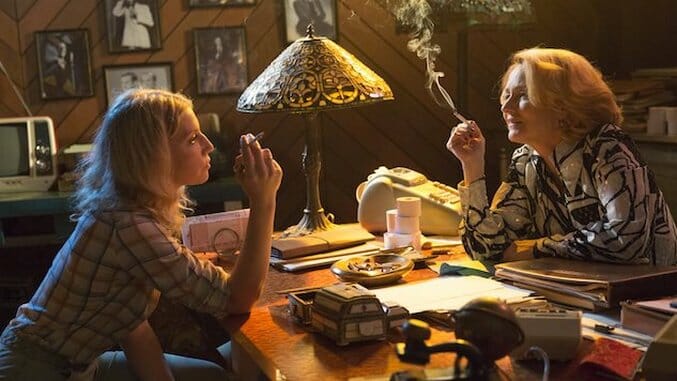Essential TV Show: I’m Dying Up Here
Image courtesy of Showtime
Note: This piece is the TV Essential in Paste Quarterly #2, which you can purchase here, along with its accompanying vinyl Paste sampler.
One of the most impactful moments in the history of American comedy was when NBC and Johnny Carson decided to move the production of The Tonight Show from New York to California. At the time, the late-night host was the kingmaker for stand-ups. A five-minute showcase on his program was enough to catapult a comedian into stardom.
So, when Carson winged it to the West Coast, a wave of hopeful funny people followed. Or, as a cab driver tells Ron and Eddie, two Boston comics (played by The Office’s Clark Duke and Michael Angarano, a.k.a Bertie The Wise from The Knick) who just landed in L.A. for a shot at the big time, in the series premiere of I’m Dying Up Here, “Ever since Carson moved his outfit from New York to here, every asshole who thinks he can tell a joke has been circling Burbank like a vulture.”
It’s a rather quaint notion in our modern era, where the insatiable hunger for content to fill up the vast empty space on every TV and podcast network or streaming service has opened up opportunities for nearly anyone with a tight five and a singular viewpoint. But 40 years ago, the gatekeepers were far stingier, and big breaks were harder to come by.
This is the world that Dying, the wonderful new Showtime series co-created by actor/comedian Jim Carrey and TV vet David Flebotte (Boardwalk Empire, Will & Grace), returns us to: the dingy, dangerous L.A. that countless stand-ups braved in hopes of getting a nod of approval from Carson and, if they were particularly great, a spot on the couch next to Ed McMahon.
In the pilot episode, that’s just what happens to Clay Appuzzo (Sebastian Stan, best known for playing The Winter Soldier in the Marvel Cinematic Universe). After rising up through the ranks at Goldie’s, a comedy club overseen by its namesake (a brassy, perfect Melissa Leo), he gets his moment in the NBC spotlight. His fellow comics crowd around a TV in the club’s kitchen, reeling with excitement and envy while Clay basks in the glow of his triumph in a lush hotel room nearby, celebrating with steak and beer. Later, he takes to the Sunset Strip and promptly walks into the path of a city bus. Killing off a major cast member is not the most original place for a TV series to start (see Six Feet Under and Fringe), but it is the perfect point of entry into the universe that orbits around Goldie’s.
-

-

-

-

-

-

-

-

-

-

-

-

-

-

-

-

-

-

-

-

-

-

-

-

-

-

-

-

-

-

-

-

-

-

-

-

-

-

-

-








































